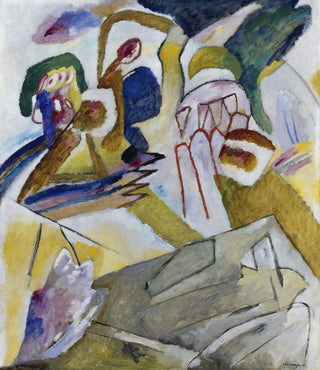Art print | Improvisation 18 with tombstone - Wassily Kandinsky


View from behind

Frame (optional)
Wassily Kandinsky's "Improvisation 18 with tombstone" is a true cry of the soul, a vibrant exploration of human emotions through color and form. Created in 1910, this iconic canvas stands out for its ability to transcend the limits of figurative representation and delve into pure abstraction. Kandinsky, a pioneer of abstract art, invites the viewer to a unique sensory experience, where every shade of color and every brushstroke resonate with emotional intensity. The tombstone, the central motif of the work, evokes reflection on mortality and the ephemeral, while engaging in a profound dialogue with spirituality and music, which were major sources of inspiration for the artist.
Style and uniqueness of the work
Kandinsky's style is characterized by bold use of color and a dynamic composition, which combine to create an atmosphere that is both chaotic and harmonious. In "Improvisation 18 with tombstone," organic and geometric shapes intertwine in a visual ballet, where vibrant shades of blue, red, and yellow oppose and complement each other. This artwork perfectly illustrates Kandinsky's color theory, which believed that each color possessed its own vibration, capable of awakening specific emotions in the viewer. The absence of clearly defined figures leaves room for personal interpretation, allowing each person to feel the work through their own emotional prism. This innovative approach not only redefined the artistic conventions of its time but also paved the way for new forms of artistic expression.
The artist and his influence
Wassily Kandinsky, born in Russia in 1866, is often considered one of the founders of abstract art. His artistic career is marked by an unceasing quest for harmony between art and spirituality. Influenced by music, he sought to translate his sound experiences into images, firmly believing that art should transcend the tangible to touch the soul. His work had a profound impact on the development of

Matte finish

View from behind

Frame (optional)
Wassily Kandinsky's "Improvisation 18 with tombstone" is a true cry of the soul, a vibrant exploration of human emotions through color and form. Created in 1910, this iconic canvas stands out for its ability to transcend the limits of figurative representation and delve into pure abstraction. Kandinsky, a pioneer of abstract art, invites the viewer to a unique sensory experience, where every shade of color and every brushstroke resonate with emotional intensity. The tombstone, the central motif of the work, evokes reflection on mortality and the ephemeral, while engaging in a profound dialogue with spirituality and music, which were major sources of inspiration for the artist.
Style and uniqueness of the work
Kandinsky's style is characterized by bold use of color and a dynamic composition, which combine to create an atmosphere that is both chaotic and harmonious. In "Improvisation 18 with tombstone," organic and geometric shapes intertwine in a visual ballet, where vibrant shades of blue, red, and yellow oppose and complement each other. This artwork perfectly illustrates Kandinsky's color theory, which believed that each color possessed its own vibration, capable of awakening specific emotions in the viewer. The absence of clearly defined figures leaves room for personal interpretation, allowing each person to feel the work through their own emotional prism. This innovative approach not only redefined the artistic conventions of its time but also paved the way for new forms of artistic expression.
The artist and his influence
Wassily Kandinsky, born in Russia in 1866, is often considered one of the founders of abstract art. His artistic career is marked by an unceasing quest for harmony between art and spirituality. Influenced by music, he sought to translate his sound experiences into images, firmly believing that art should transcend the tangible to touch the soul. His work had a profound impact on the development of






